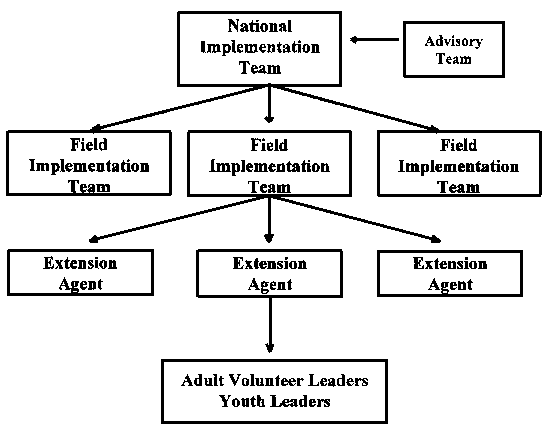Group 1 - Strategies for reaching Rural Youth and integrating population education concepts for Rural Youth programmes
Group 2 - Operational aspects of institutionalization
Mr. Mas'ud Panjaitan (Indonesia), Discussion Leader
Ms. Nguyen Thi Hoang Van (Vietnam), Rapporteur
Ms. Zhang Lei (China)
Ms. Li Xuigi (China)
Ms. Jembarsah (Indonesia)
Mr. Thotsaporn Maneeratana (Thailand)
Ms. Natharin Sangthong (Thailand)
Mr. Suwat Manimont (Thailand)
Ms. Doan Thi Tine (Vietnam)
Mr. Nguyen Dong Linh (Vietnam)
Mr. Vu Va Tien (Vietnam)
Resource Persons
Mr. R. William Seiders
Ms. Margaret Torrance
Topics:
· New participatory techniques for assessing the needs of rural youth.· Entry points for the development of materials/ curricula.
· Modalities for reaching rural youth (programmes, activities, training, material development, income-generation, peer groups, etc.)
· Integrating additional relevant subject matter content
New participatory techniques for assessing the needs of rural youth
· Officials should work together with youth from the beginning in order to assess needs effectively, so plans can come from the youth themselves.· Youth should develop plans themselves so that they take ownership, thus they will understand, agree, and be willing to participate in them.
· Surveys, investigations, socio-cultural research, and studies approaching family and formal/informal community leaders before initiating programs
Entry points for the development of materials/ curricula
· Integration of teachers, parents, and other related persons.· Posters, newsletters, booklets, leaflets, radio, TV, video, loud speaker, exhibitions, etc. This could include easily movable teaching aids such as flip charts and flannel cloth boards.
· More pictures than words in the educational materials.
· Modules should be organized in a format for gradual teaching rather than presenting all information at once.
· Inter-community visits at regional, national, and international levels to motivate learners.
Modalities for reaching rural youth (programmes, activities, training, material development, income-generation, peer groups, etc.)
Entertainment activities such as sports, picnics, etc.; income-generating activities; competition; different kinds of clubs (i.e. youth clubs, dancing clubs, singing clubs, etc.); counseling centers; HIV/AIDS support groups
Integrating additional relevant content
· Sex and sexual behavior content must be presented in culturally appropriate ways. Issues that should be integrated include HIV/AIDS, safe and healthy sex, reproductive health, primary health care, and age and marriage.· Equality for men and women should be the goal. Implementers should encourage and create conditions so that women will be able to function as volunteer leaders. Season and location should be considered with regard to training.
Mr. Apichai Chingprapa (Thailand), Discussion Leader
Ms. Dedeh Krisdhiani (Indonesia), Rapporteur
Mr. Luhut Hutabarat (Indonesia)
Ms. Lu Jun (China)
Mr. Zhang De (China)
Mr. Ath Intharak (Thailand)
Mr. Widjatmiko (Indonesia)
Project Organization and Institutional Structure
· Appointment of a national implementation team to be responsible for project planning and operational management.· Advisory committee should consist of representatives from agencies with functions related to specific issues of rural populations. Therefore, the policies, strategies, and programmes of each ministry can be integrated, so the coordination among agencies will be more efficient.
· To strengthen the capacity of the national implementation team, there should be project personnel responsible for financial and administrative matters.
Besides the project national team and advisory committee, it is important to set up a field implementation team at the provincial/district level. This team, under the close supervision of the national project team, will carry out project activities in the field. The organizational structure of the project is suggested in the chart on the following page.
Funding
Sources of funding include the following:
· Donor agencies, especially to cover the cost of project preparation and pilot projects as well as networking activities.· Related government agencies
· NGO's
· Private enterprises
· Fund raising
3. Control
To ensure the project is implemented as expected, the following activities should be conducted.
· Effective monitoring and evaluation· Supervision
· Training for staff development: Trainers should be trained in communication skills and training skills; and field staff and village youth leaders should be trained on the above as above but also on technical and economic subjects which are needed by rural youth.
· Population education should be included in the concerned agencies' policies and workplans.
Figure 1. Recommended organizational structure for population education
